

Best practices of Operational Excellence Journey Methodologies. Our answer is yes. Every tool/methodology has unique features that helps for every business. Best practices of Operational Excellence Journey Methodologies. Lean Transformation Roadmap. Time Frame : Dependent on Variables Results At the end of Phase Three, an organization is building upon already-found gains.

It is experiencing major breakthroughs and its performance is moving forward at a constant pace. When an organization reaches Phase Four, there is some danger it may fail to recognize lean is a journey that is never complete. Because the company experiences constant breakthroughs in performance, its leaders and workers may become complacent and even arrogant.
Education Education is the cornerstone upon which lean will continue to grow and develop. Application Lean is now not only integrated into every day-to-day activity in the organization, but is fully integrated into every decision-making thought process. Communication In Phase Four, a company should be communicating about lean externally with suppliers, customers, financial institutions – even the community. Infrastructure Time Frame : Ongoing. Lean Transformation Roadmap. Quality Improvement in the Workplace. We asked a question to our linked-in group members. In the equation Y=F(x), where Y= organization culture and x1, x 2 etc… are factors influence the culture, identify those factors. Also what are the 3 xs strongly influence the culture? We received various answers like Geographic location, Value system, Vision, Constancy of purpose, leadership, Management commitment, external environment, Quality Management systems, Human Resource development etc…most of them are interrelated.
Quality Improvement in the Workplace. Standard Work Methodology- How To Sustain Daily Operations In Lean Practicing Companies. Standard work is one of the fundamental Lean tool for defining the best combination of man and machine activity for the best productivity.

It consists of timing for different elemental activities, the path to be followed by the operator in doing the activities. Standard work has 3 elements: Takt timeStandard sequence for doing the workWork In Process to produce products without any stockout situations Takt time is the time within which the product to be produced to meet the customer demand. Standard Work Methodology- How To Sustain Daily Operations In Lean Practicing Companies. Objectives of Jishu Hozen (Autonomous Maintenance)
Life of equipment depends not only on how well it is used but also on how well it is maintained. Various versions of maintenance techniques are in use. Total Productive Maintenance popularized by Japanese is one of the best methodology used worldwide There are 8 pillars of implementing Total Productive Maintenance Focussed improvementAutonomous MaintenancePlanned MaintenanceEducation and trainingEarly ManagementQuality MaintenanceAdministration and support department activitiesSafety, Health, and environment management. Related Article– What Is The Significance Of Doing Step By Step Audit In TPM– Autonomous Maintenance Implementation.
In this article, we will discuss more on the Autonomous Maintenance application and implementation steps. Objectives of Jishu Hozen (Autonomous Maintenance) Standard Operations- Need for Standard Operations. What is the Need for Standard Operations?
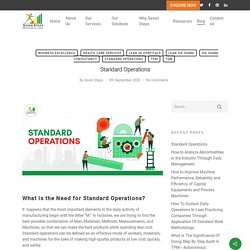
It happens that the most important elements in the daily activity of manufacturing begin with the letter “M.” In factories, we are trying to find the best possible combination of Men, Materials, Methods, Measurements, and Machines, so that we can make the best products while spending less cost. Standard operations can be defined as an effective mode of workers, materials, and machines for the sake of making high-quality products at low cost, quickly, and safely. Standard operations comprise the backbone of JIT(Just in Time) production. Standard Operations- Need for Standard Operations. Quality Improvement in the Workplace. Quality Improvement in the Workplace. Implementing the 5S Methodology, Visual management systems. Implementing the 5S Methodology, Visual management systems. Quality Improvement in the Workplace. TQM,TPM,LEAN,SIXSIGMA: Right strategy for organization’s business excellence journey.
1.0: The need for Business Excellence Journey? There are four Cs which drive organization for Business Excellence. Competition, Customer, Company/CEO Vision and Crisis. Today organizations have one or more of above reasons for taking Business Excellence Journey. Note: Some organizations call it Operational Excellence which is according to the author is a sub-set of Business Excellence. While Business Excellence addresses the complete business environment including all stake holders, Operational excellence addresses the factors like productivity, quality, cost, delivery, morale, safety and service to customers. For Example:Operational Excellence may not cover market threats.
Related Article– Implementing Visual Management to complement Operational Excellence 3.0: How we know what right strategy is? Before we answer this question, let us understand highlights of some of the popular business excellence strategies. 3.1: Some popular Business Excellence Strategies 3.1.2: Lean 3.1.4: Six Sigma. Lean Transformation Roadmap. How Lean Manufacturing will help to improve Productivity. Lean is the term which has core philosophy of doing more and more with less and less.
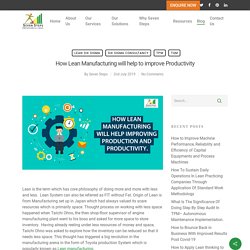
Lean System can also be referred as FIT without Fat. Origin of Lean is from Manufacturing set up in Japan which had always valued its scare resources which is primarily space. Thought process on working with less space happened when Taiichi Ohno, the then shop-floor supervisor of engine manufacturing plant went to his boss and asked for more space to store inventory. Having already reeling under less resources of money and space, Taiichi Ohno was asked to explore how the inventory can be reduced so that it needs less space. This thought has triggered a big revolution in the manufacturing arena in the form of Toyota production System which is popularly known as Lean manufacturing. Unlike mass production where economics of scale, low variety and high volume were the norm. Increase in production is possible through productivity improvement. Phases of Lean Transformation. Lean is a way of thinking.
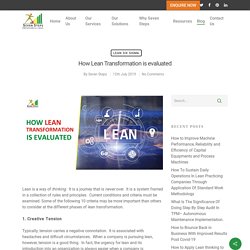
It is a journey that is never over. It is a system framed in a collection of rules and principles. Current conditions and criteria must be examined. Effective Lean Daily Work Management System. With Lean Daily Work Management System at the core of its operations, an organization will be able to quickly identify deviation, start solving problems and make strategy deployment a success.
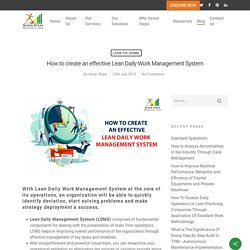
Lean Daily Management System (LDMS) comprises of fundamental components for dealing with the presentation of tasks from operations. LDMS helps in improving overall performance of the organization through effective management of key tasks and timelines. With straightforward and powerful visual tools, you can streamline your operational exhibition by eliminating the sources of variation brought about by traditional management and oversight practices.Lean Daily Work Management will assist you with establishing a precise way to deal with oversee the same affairs, delegate, empower and manage performance of business/process.
Lean Start-ups for the most part centre more on boot tying and creating products and services utilizing Lean standards. Strategy deployment to all departments Primary Visual Display. Lean Manufacturing in Garment Industry. The Lean Manufacturing concept in the Apparel Industry can diminish the operational expense in manufacturing by wiping out the process waste, engaging individuals with more prominent communication, expanding the higher efficiency in the execution procedure and transforming the company into a learning organization.

Lean Manufacturing is a precise methodology for accomplishing the shortest possible cycle time by eliminating the process waste through continuous improvement. In this way making the activity productive and just comprising of value adding steps from beginning to end. Best practices of Operational Excellence Journey Methodologies. Lean Layouts and Cellular Manufacturing. Traditionally, many conventional factory design had common manufacturing method of Job shop which is organised based on the concept where all similar operations are grouped and put in one room with a supervisor or a manager.
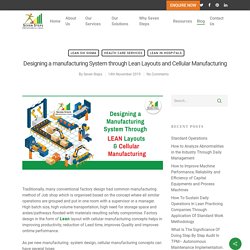
High batch size, high volume transportation, high need for storage space and aisles/pathways flooded with materials resulting safety compromise. Factory design in the form of Lean layout with cellular manufacturing concepts helps in improving productivity, reduction of Lead time, improves Quality and improves ontime performance. As per new manufacturing system design, cellular manufacturing concepts can have several types.